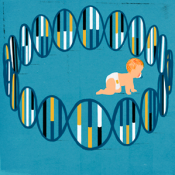Sequencing projects will screen 200,000 newborns for disease genes
By Jocelyn Kaiser,
Science
| 12. 12. 2022
The once-futuristic idea of sequencing every newborn child’s DNA to screen for genes that could shape their future health is being put to two major tests. The United Kingdom today announced plans to sequence the genomes of 100,000 newborns for about 200 rare genetic diseases starting next year. In New York City, a similar project already underway will screen for a slightly larger number of diseases in 100,000 babies from the city’s diverse population.
The goal is to catch treatable diseases that standard newborn screenings cannot detect. If sequencing delivers an early warning of a problem, the baby could receive care that averts permanent disability or even death.
But sequencing the full genomes of newborns raises a host of ethical questions, including who will get access to the data, and whether it will needlessly worry parents by revealing genes that may never cause serious illness. “We’re really cognizant of the complexity of the questions,” says Richard Scott, chief medical officer for Genomics England, the government-funded company running the U.K. project. At the same time, he says, “There’s a really...
Related Articles
By Josie Ensor, The Times | 12.09.2025
A fertility start-up that promises to screen embryos to give would-be parents their “best baby” has come under fire for a “misuse of science”.
Nucleus Genomics describes its mission as “IVF for genetic optimisation”, offering advanced embryo testing that allows...
By Hannah Devlin, The Guardian | 12.06.2025
Couples undergoing IVF in the UK are exploiting an apparent legal loophole to rank their embryos based on genetic predictions of IQ, height and health, the Guardian has learned.
The controversial screening technique, which scores embryos based on their DNA...
By Frankie Fattorini, Pharmaceutical Technology | 12.02.2025
Próspera, a charter city on Roatán island in Honduras, hosts two biotechs working to combat ageing through gene therapy, as the organisation behind the city advertises its “flexible” regulatory jurisdiction to attract more developers.
In 2021, Minicircle set up a...
By Vardit Ravitsky, The Hastings Center | 12.04.2025
Embryo testing is advancing fast—but how far is too far? How and where do we draw the line between preventing disease and selecting for “desirable” traits? What are the ethical implications for parents, children, clinicians, and society at large? These...




